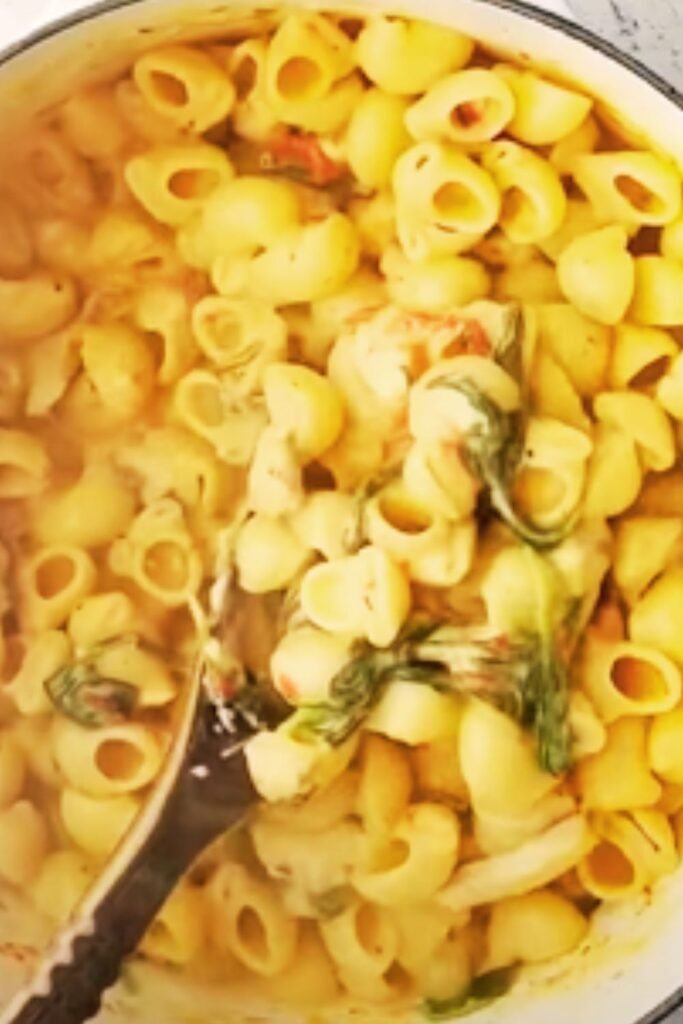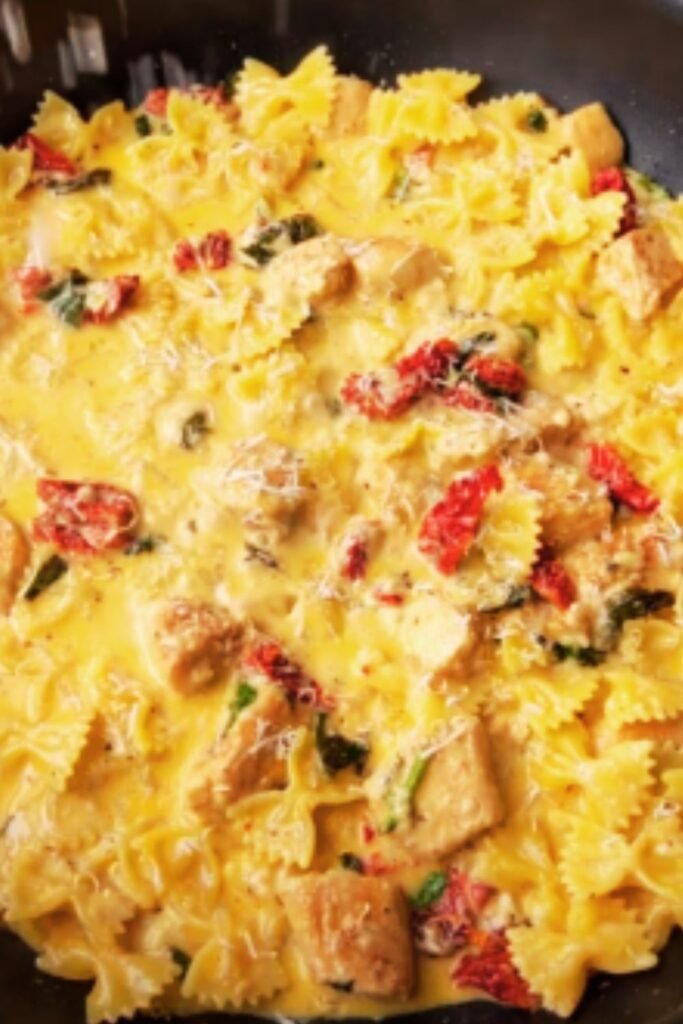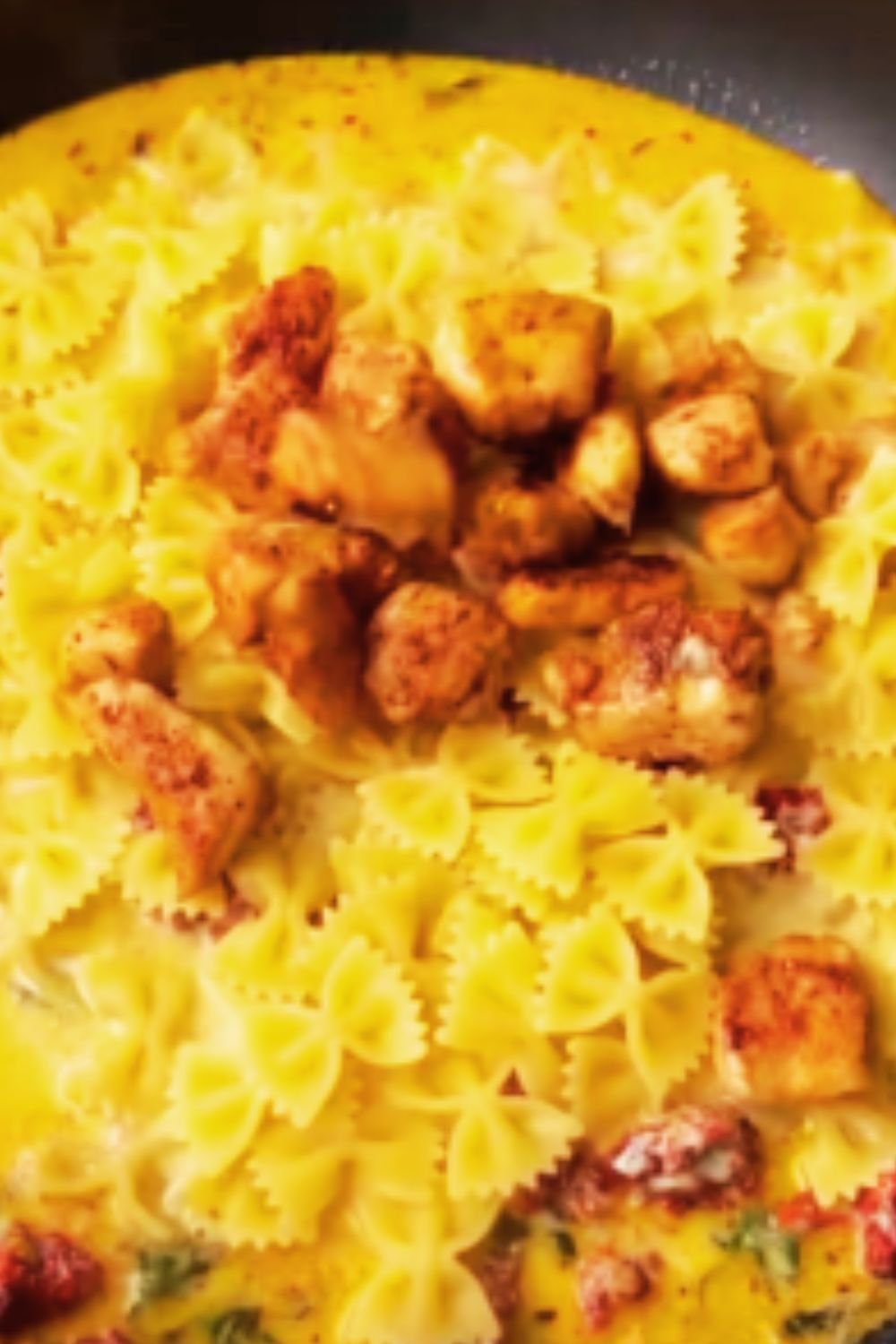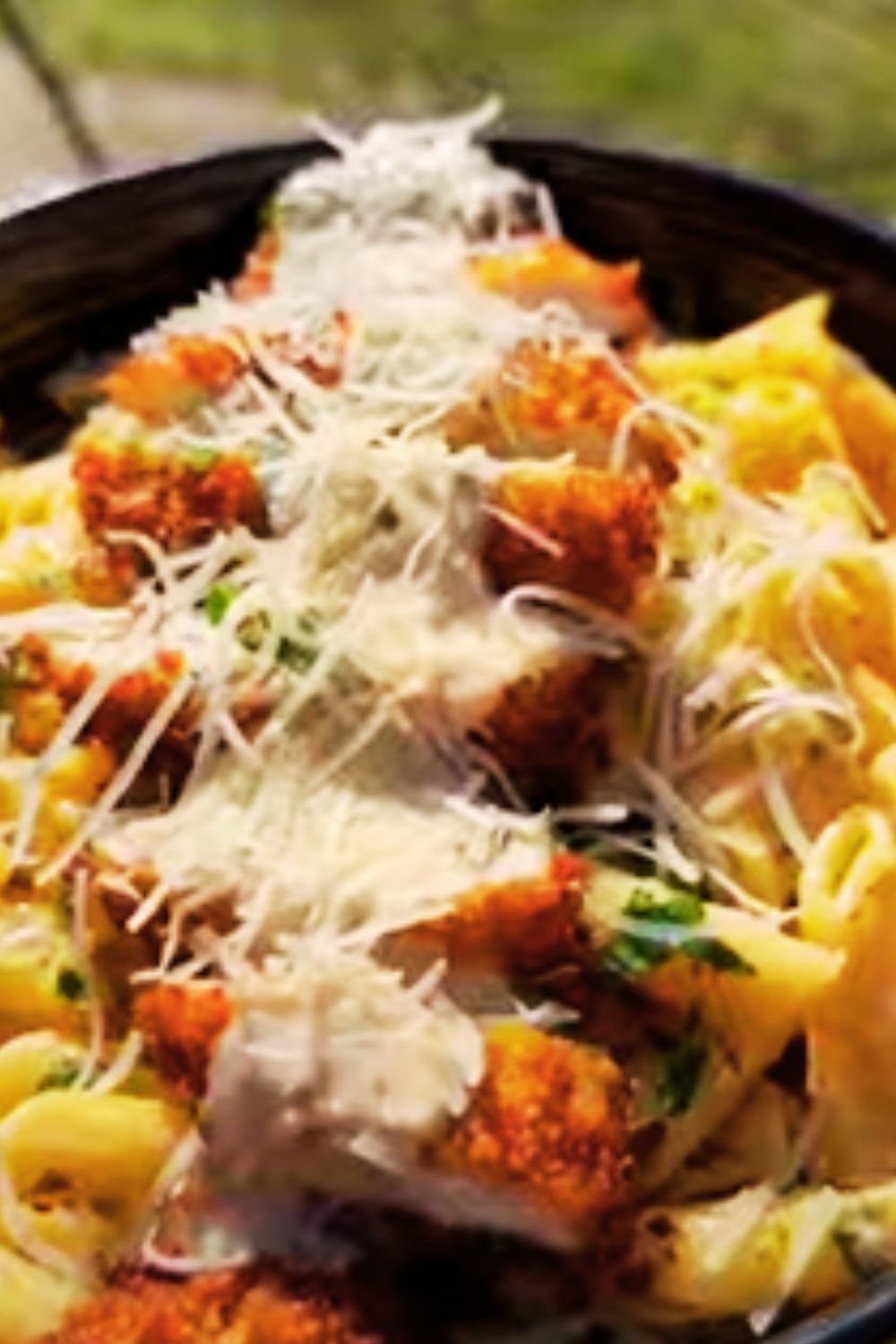There’s something magical about the combination of tender chicken, sun-dried tomatoes, and spinach swimming in a creamy garlic parmesan sauce. This Creamy Tuscan Chicken Pasta has become my go-to recipe when I want to impress dinner guests without spending hours in the kitchen. I first stumbled upon a version of this recipe years ago at a small Italian restaurant in my hometown, and I’ve been perfecting my homemade version ever since.
What makes this dish truly special is its balance of rich, creamy indulgence with the brightness of Italian herbs and sun-dried tomatoes. It’s like a vacation to the Tuscan countryside in each bite, bringing together classic Mediterranean flavors in one satisfying meal.
What Makes This Tuscan Chicken Pasta Special
This isn’t just any chicken pasta recipe. The “Tuscan” element comes from the combination of ingredients that evoke the flavors of Tuscany in central Italy—garlic, sun-dried tomatoes, spinach, Italian herbs, and a rich, creamy sauce. While perhaps not strictly authentic to traditional Tuscan cuisine, this Americanized version has become wildly popular for good reason!
I’ve tested countless variations of this recipe, adjusting ingredients and proportions until I found the perfect balance. The result is a pasta dish that’s:
- Ready in just 30 minutes from start to finish
- Made in one pot for minimal cleanup
- Impressive enough for company but easy enough for weeknights
- Adaptable to what you have on hand
- Absolutely bursting with flavor in every bite
Kitchen Tools You’ll Need
Before we dive into making this incredible pasta, let’s make sure you have everything you need:
- Large skillet or sauté pan (12-inch is ideal)
- Sharp knife for cutting chicken
- Cutting board
- Measuring cups and spoons
- Wooden spoon or spatula
- Tongs for tossing pasta
- Microplane or fine grater for fresh parmesan (optional)
Ingredients for Creamy Tuscan Chicken Pasta
For the Chicken:
- 1½ pounds boneless, skinless chicken breasts (about 3 medium breasts)
- 1 teaspoon Italian seasoning
- ½ teaspoon garlic powder
- ½ teaspoon salt
- ¼ teaspoon black pepper
- 2 tablespoons olive oil
For the Sauce:
- 4 cloves garlic, minced (about 2 tablespoons)
- ½ cup sun-dried tomatoes, julienned (oil-packed, drained)
- 1 tablespoon all-purpose flour
- 1 cup chicken broth
- 1½ cups heavy cream
- 1 teaspoon Italian seasoning
- ½ cup freshly grated Parmesan cheese
- 4 cups fresh spinach leaves (about 4 ounces)
- Salt and pepper to taste
For the Pasta:
- 12 ounces fettuccine or pappardelle pasta
- Reserved pasta water (as needed)
Optional Garnishes:
- Fresh basil leaves, thinly sliced
- Extra Parmesan cheese
- Red pepper flakes for heat
- Fresh ground black pepper
Step-by-Step Instructions

Step 1: Prepare the Chicken
- Cut chicken breasts into 1-inch cubes and place in a medium bowl.
- Season chicken with Italian seasoning, garlic powder, salt, and pepper, tossing to coat evenly.
- Heat olive oil in a large skillet over medium-high heat.
- Add the seasoned chicken to the hot skillet in a single layer (work in batches if necessary to avoid overcrowding).
- Cook for 4-5 minutes, turning occasionally, until golden brown on all sides and cooked through (internal temperature of 165°F/74°C).
- Transfer the cooked chicken to a plate and set aside.
Step 2: Cook the Pasta
- While the chicken is cooking, bring a large pot of water to a boil.
- Add a generous pinch of salt to the boiling water.
- Cook pasta according to package directions until al dente (usually 9-11 minutes).
- Before draining, reserve 1 cup of pasta cooking water.
- Drain pasta and set aside.
Step 3: Make the Creamy Tuscan Sauce
- In the same skillet used for the chicken, reduce heat to medium and add minced garlic.
- Cook for 30 seconds until fragrant, being careful not to burn the garlic.
- Add sun-dried tomatoes and stir for another 30 seconds.
- Sprinkle flour over the garlic and tomatoes, stirring constantly for 1 minute to cook the raw flour taste out.
- Slowly pour in chicken broth while whisking to prevent lumps from forming.
- Add heavy cream and Italian seasoning, stirring to combine.
- Bring sauce to a gentle simmer (do not boil) and cook for 3-4 minutes until it begins to thicken.
- Reduce heat to low and stir in the grated Parmesan cheese until melted and smooth.
Step 4: Combine Everything
- Add the fresh spinach to the sauce and stir until wilted, about 1-2 minutes.
- Return the cooked chicken to the skillet, stirring to coat with sauce.
- Add the drained pasta directly to the skillet, tossing everything together with tongs.
- If the sauce seems too thick, add a splash of the reserved pasta water to reach your desired consistency.
- Taste and adjust seasoning with salt and pepper as needed.
Step 5: Serve and Garnish
- Remove from heat and let the pasta rest for 2-3 minutes to allow the sauce to thicken slightly.
- Serve in warmed bowls or plates.
- Garnish with fresh basil, additional Parmesan cheese, and a sprinkle of red pepper flakes if desired.
Flavor Variations to Try

One of the reasons I love this recipe is how versatile it is. Here are some of my favorite ways to switch it up:
Protein Options:
- Substitute chicken with large shrimp (cook for just 2-3 minutes per side)
- Use Italian sausage instead of chicken for a more robust flavor
- For a vegetarian version, use sautéed mushrooms or white beans
Vegetable Add-ins:
- Add roasted red peppers for extra sweetness
- Mix in artichoke hearts for Mediterranean flair
- Toss in some black olives for briney depth
- Include cherry tomatoes in the last few minutes of cooking
Pasta Variations:
- Try it with tortellini or ravioli for an extra-special touch
- Use whole wheat pasta for added fiber
- For a lower-carb option, serve over zucchini noodles
Sauce Adjustments:
- Add a splash of white wine before the broth for depth of flavor
- Stir in a tablespoon of pesto for an herby kick
- Use half-and-half instead of heavy cream for a lighter sauce
- Add a pinch of nutmeg to enhance the creamy sauce
Make-Ahead and Storage Tips
Make-Ahead Options:
I find this dish is best made fresh, but you can:
- Prep the chicken (cut and season) up to 24 hours ahead and refrigerate
- Measure and prep all other ingredients the day before
- Make the entire dish up to 2 days ahead, but cook the pasta just slightly less than al dente
Storing Leftovers:
- Allow pasta to cool completely before transferring to airtight containers.
- Refrigerate for up to 3-4 days.
- Freeze portions for up to 2 months (though the cream sauce may separate slightly upon thawing).
Reheating Instructions:
- Stovetop (best method): Add leftovers to a skillet with 2-3 tablespoons of milk or chicken broth. Cover and heat over medium-low heat, stirring occasionally until warmed through.
- Microwave: Place portion in a microwave-safe dish, add a splash of milk or water, cover with a damp paper towel, and heat in 30-second intervals, stirring between each.
Nutritional Information
For those who are tracking their intake, here’s the approximate nutritional breakdown per serving (based on 6 servings):
| Nutrient | Amount per Serving |
|---|---|
| Calories | 625 |
| Protein | 35g |
| Carbohydrates | 42g |
| Fat | 38g |
| Saturated Fat | 19g |
| Cholesterol | 165mg |
| Sodium | 580mg |
| Fiber | 3g |
| Sugar | 4g |
Serving Suggestions

This Creamy Tuscan Chicken Pasta is truly a complete meal on its own, but I love serving it with:
- A simple green salad with balsamic vinaigrette
- Garlic bread or crusty Italian bread
- Roasted asparagus or broccolini
- A small Caesar salad
- Sautéed zucchini or summer squash
For a special touch, I sometimes serve this pasta in warmed bowls with a small dish of extra Parmesan on the table. It makes even a weeknight dinner feel like a special occasion!
Common Questions and Troubleshooting
Q: My sauce is too thin. How can I thicken it?
If your sauce isn’t thickening properly, there are a few easy fixes:
- Continue simmering the sauce for a few more minutes
- Make a slurry of 1 teaspoon cornstarch mixed with 1 tablespoon cold water and stir it into the simmering sauce
- Add a bit more grated Parmesan cheese
- Remove from heat and let it sit for 5 minutes (it will thicken as it cools slightly)
Q: Can I use milk instead of heavy cream?
While heavy cream provides the richest texture, you can substitute with:
- Half-and-half (with similar results)
- Whole milk whisked with 1 tablespoon of cornstarch (for a lighter version)
- For a dairy-free option, full-fat coconut milk works surprisingly well
Q: What can I substitute for sun-dried tomatoes?
If you don’t have sun-dried tomatoes on hand:
- Roasted red peppers work beautifully
- Fresh cherry tomatoes (halved and sautéed until slightly softened)
- A tablespoon of tomato paste plus a teaspoon of sugar can provide that sweet-tangy flavor
Q: My spinach released too much water and made my sauce watery. Help!
This can happen with particularly fresh or wet spinach. Next time:
- Make sure your spinach is completely dry before adding
- Add spinach right at the end, just before serving
- Use slightly less spinach
- Let the sauce reduce a bit longer after adding the spinach
Q: Can I make this dish gluten-free?
Absolutely! Simply:
- Use your favorite gluten-free pasta
- Substitute the all-purpose flour with cornstarch (1 tablespoon) or gluten-free flour blend
- Double-check your chicken broth is gluten-free
Tips from My Kitchen to Yours

After making this dish countless times, I’ve gathered some insider tips that really elevate this recipe:
- Season in layers: Season the chicken well, then taste and adjust the sauce seasonings separately before combining.
- Don’t overcook the pasta: Aim for al dente or even 1 minute less since the pasta will continue cooking when added to the hot sauce.
- Quality ingredients matter: Use real Parmigiano-Reggiano cheese (not the pre-grated kind in a can) and good quality sun-dried tomatoes for the best flavor.
- Temperature control is key: Keep the sauce at a gentle simmer, never a full boil, to prevent the cream from separating.
- Fresh herbs make a difference: If you can, finish with fresh basil rather than dried for a burst of aromatic flavor.
- Let it rest: Allow the finished dish to sit for 2-3 minutes before serving to let the sauce thicken and the flavors meld.
- Baby spinach is best: It’s more tender and requires less cooking time than regular spinach.
- Oil-packed sun-dried tomatoes: These have more flavor than dry-packed and release some of their infused oil into the sauce.
Why This Recipe Works
What makes this Creamy Tuscan Chicken Pasta truly special is the perfect balance of flavors and textures. The richness of the cream sauce is cut by the tanginess of the sun-dried tomatoes. The tender chicken provides satisfying protein while the wilted spinach adds freshness and color.
The secret to the sauce’s incredible depth of flavor is building it in the same pan where you cooked the chicken—those browned bits at the bottom (what chefs call “fond”) dissolve into the sauce, adding complexity that can’t be achieved any other way.
This dish also strikes the ideal balance between impressive and accessible. It looks and tastes like something from a high-end Italian restaurant, but it’s simple enough for even novice cooks to master.
Final Thoughts
This Creamy Tuscan Chicken Pasta has become my signature dish for good reason. It’s elegant enough for company but easy enough for a weeknight dinner. The combination of tender chicken, sun-dried tomatoes, and spinach in a velvety garlic parmesan sauce creates a meal that’s both comforting and sophisticated.
I hope you enjoy making and eating this pasta as much as I do. There’s something truly special about creating a restaurant-quality meal in your own kitchen, and this recipe delivers that experience every time. Whether you’re cooking for family, friends, or just treating yourself to something special, this Tuscan chicken pasta is sure to impress.
Remember, cooking is about making the recipe your own, so don’t be afraid to adjust ingredients to suit your taste. The beauty of this dish is its versatility and forgiving nature. Enjoy the process, and most importantly, enjoy the meal!
Frequently Asked Questions
Q: Can I make this with boneless chicken thighs instead of breasts?
Absolutely! Boneless, skinless chicken thighs work beautifully in this recipe and often result in juicier meat. Just cut them into similarly sized pieces and cook them the same way. They may take a minute or two longer to cook through.
Q: How can I make this dish lighter in calories?
To create a lighter version:
- Use half-and-half or evaporated milk instead of heavy cream
- Reduce the amount of Parmesan to ¼ cup
- Increase the vegetables by adding more spinach or other veggies
- Use less pasta and more vegetables to adjust the ratio
Q: Can I make this dish ahead for a dinner party?
Yes! You can prepare it up to a day ahead, but I recommend these steps for best results:
- Slightly undercook both the pasta and the sauce (it will thicken when refrigerated)
- Store the pasta and sauce separately if possible
- When reheating, add a splash of broth or cream to loosen the sauce
- Garnish with fresh herbs just before serving
Q: What wines pair well with Creamy Tuscan Chicken Pasta?
This rich pasta dish pairs beautifully with:
- A crisp Pinot Grigio to cut through the creaminess
- A medium-bodied Chardonnay that complements the creamy sauce
- A light Sangiovese to honor the Tuscan inspiration
Q: How can I add some heat to this dish?
If you enjoy spicy food, try one of these additions:
- Add ¼ to ½ teaspoon of red pepper flakes when sautéing the garlic
- Drizzle with chili oil before serving
- Add a diced fresh chili pepper when cooking the chicken
- Finish with freshly cracked black pepper with a touch of cayenne
Q: Is there a dairy-free version of this recipe?
Yes, you can make a dairy-free version by:
- Substituting the heavy cream with full-fat coconut milk or cashew cream
- Using nutritional yeast or dairy-free Parmesan alternative instead of cheese
- Adding a squeeze of lemon juice to brighten the flavor (since you’ll miss the tanginess from the cheese)
Q: What’s the best type of pasta to use in this recipe?
While I recommend fettuccine or pappardelle because their wide surface area holds the sauce beautifully, you can also use:
- Rigatoni or penne, which catch sauce in their ridges and hollow centers
- Linguine for a slightly lighter feel
- Farfalle (bow ties) for a fun presentation
- Cavatappi for plenty of sauce-clinging curves
Remember, the best pasta is the one you enjoy most or happen to have in your pantry!


